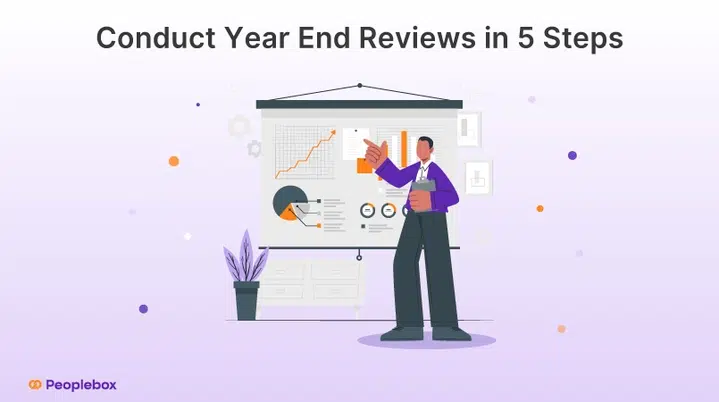When the year draws to a close, the time to reflect on the accomplishments, challenges, and growth of the past year also closes in. Year end reviews play a pivotal role in this process, providing a structured framework to assess employee performance, provide feedback, and align goals with organizational objectives. It sets the stage for growth and success in the upcoming year.
But wait, you might be wondering, what exactly is an end of year review, and how does it differ from an annual review?
While the terms are often used interchangeably, there is a subtle distinction between the two. A year end performance review is a comprehensive evaluation conducted at the end of the calendar or fiscal year.
Unlike annual reviews that may occur at different intervals, the year end review focuses specifically on the accomplishments, challenges, and growth opportunities that have transpired throughout the entire year.
In this blog, we will guide you through everything you need to know about year end reviews and five essential steps to conduct them effectively.
What is the Use of Conducting Year End Reviews?
The purpose of conducting year end reviews goes beyond mere formality as it serves as a powerful tool for enhancing employee engagement, development, and organizational success.
Year end reviews allow managers to provide feedback, recognize achievements, and identify areas for improvement. These reviews align individual goals with organizational objectives, ensuring a collective focus on shared aspirations.
The process sets clear expectations, discusses performance, and establishes new goals for success in the coming year.
The reasons why conducting these reviews is essential:
1. Personal and organizational growth

Year end reviews provide employees with a dedicated platform to reflect on their performance, achievements, and areas for improvement. Through constructive feedback and discussions, employees gain valuable insights into their strengths and areas of growth. This, in turn, contributes to the overall talent pool of the company, leading to improved productivity, efficiency, and innovation.
2. Positive impact on employee engagement and motivation
Recognition and feedback received during these reviews validate employees’ hard work and contributions, fostering a sense of value and appreciation. Open and transparent communication nurtures a supportive work environment, boosting employee satisfaction, commitment, and overall engagement. Engaged and motivated employees contribute their best efforts, driving the company’s success.
3. Alignment of individual goals with organizational objectives
They provide a strategic opportunity to align individual goals with the larger objectives of the organization. This alignment ensures that everyone within the organization is moving in the same direction, working collaboratively towards shared aspirations. When individual goals are in harmony with the organization’s objectives, it leads to increased productivity, efficiency, and overall success.
Step-by-Step Guide to Conducting a Year End Review
Step 1: Set Clear Objectives and Expectations
Setting clear objectives and expectations is a crucial first step in conducting a successful year end review. This ensures that everyone is on the same page regarding performance evaluation and the desired outcomes.
Here’s how you can effectively carry out this step:
A. Communicate performance review plans – Define performance criteria and expectations

Clearly communicate the purpose, timeline, and process of the year-end review to all employees and managers. This includes defining the performance criteria and expectations that will be used to assess employee performance. Providing this information in advance allows everyone to understand what will be evaluated and the standards they should strive for.
B. Prepare managers and employees for performance conversations
Managers should understand the review process, the performance criteria, and how to deliver feedback effectively. Additionally, employees should be informed about what to expect during the review, including the areas that will be evaluated, the format of the conversation, and any documentation or self-assessment they may need to prepare.
C. Prepare for the review – Develop review questions and review past assessment results
Prior to the review, develop a set of thoughtful and relevant review questions that will guide the conversation. These questions should cover various aspects of performance, such as accomplishments, challenges, development opportunities, and future goals. Additionally, review any past assessment results or performance records to have a comprehensive understanding of the employee’s progress.
Step 2: Gather and Analyze Performance Data
The analysis of performance data forms the basis for constructive feedback. It helps identify areas of strength and areas for improvement, setting the stage for meaningful discussions during the year end review.
To gather a well-rounded perspective of an employee’s performance, it is important to consider multiple sources of data. This includes self-assessments, where employees reflect on their own accomplishments, challenges, and areas for growth.
Manager evaluations provide insights from the direct supervisor, while peer-to-peer assessments allow for feedback from colleagues who have worked closely with the employee.
Each source of data offers unique perspectives that contribute to a more comprehensive evaluation.
Importance of using quantitative and qualitative data for a holistic view
It is crucial to consider both quantitative and qualitative data when analyzing performance. Quantitative data may include measurable metrics such as sales targets achieved, project completion rates, or customer satisfaction ratings.
On the other hand, qualitative data offers subjective insights into an employee’s behavior, communication skills, teamwork, and problem-solving abilities.
By incorporating both types of data, a more holistic view of performance can be obtained, providing a well-rounded objective assessment.
Step 3: Schedule and Conduct Review Meetings
A. Set up effective review meetings – 1:1s

Schedule dedicated 1:1 meetings with each employee to discuss their performance and progress. This individualized approach ensures that employees receive personalized feedback and guidance tailored to their unique circumstances. 1:1 review meetings also create an environment conducive to open communication, allowing employees to express their thoughts, concerns, and aspirations freely.
Read More: One on One meetings: The Ultimate Guide for Managers
B. Create a comfortable and constructive environment
When conducting review meetings, it is essential to create a comfortable and supportive environment.
- Start by setting a positive tone and creating a safe space for open communication.
- Encourage employees to share their thoughts, perspectives, and concerns freely.
- Listen actively and attentively, showing empathy and understanding.
- Use constructive language and focus on providing feedback that is specific, actionable, and supportive.
- Keep the conversation focused on growth and development rather than dwelling solely on past mistakes or shortcomings.
Step 4: Offer Constructive Feedback and Create Action Plans for Improvement and Development
For making the year end review process a success, it’s essential to offer constructive feedback to employees and create action plans for their improvement and development.
This step focuses on helping employees identify areas for growth and providing guidance on how to achieve their goals.
Here are some key points to consider:
A. Create an agenda for your development talk
Before engaging in the feedback and development discussion, create an agenda to structure the conversation.
This agenda should outline the key points to cover, such as highlighting strengths, discussing areas for improvement, and setting development goals. This ensures that the discussion remains focused and productive.
B. Curate a development plan and offer guidance on personal plans for growth
As part of the end of year review, HRs and managers should work together with employees to create a development plan. This plan should outline specific actions and milestones for the employee to pursue their growth objectives.
It may include training programs, mentoring opportunities, skill-building projects, or stretch assignments.
Support employees in their development efforts by providing the necessary resources, tools, and training opportunities. Ongoing support demonstrates your commitment to employees’ growth and increases the likelihood of successful development outcomes.
Step 5: Follow-up
The final step of a successful year end review process is to prioritize follow-up actions. This ensures that the outcomes of the year end review process are translated into tangible progress and growth.
Follow-up ensures that the feedback, goals, and development plans discussed during the review are effectively implemented and progress is tracked. Here’s how you can do that:
- Set a clear timeline with specific checkpoints to review progress. Communicate this timeline to employees, emphasizing the importance of accountability and commitment to their growth plans.
- Schedule regular check-in meetings with employees to discuss their progress, address challenges, and provide guidance or feedback.
- Recognize and celebrate milestones and achievements along the way.
How to Prepare for a Year End Review for HR, Manager, Employees
HR’s Role in Preparing for Reviews
- HR gathers accurate and relevant performance data from various sources, such as metrics, self-assessments, evaluations, and feedback. They analyze this data to provide meaningful insights for objective evaluations.
- HR establishes clear criteria and guidelines aligned with organizational objectives. They train managers on fair and unbiased evaluation practices to maintain a level playing field.
- HR establishes timelines, communication plans, and guidelines for managers and employees. They provide resources and forms to facilitate a smooth and standardized review process.
Read More: The Top 5 Consequential Challenges HRs Face as a Result of Bad Performance Review
Manager’s Role in Preparing for Reviews
- Managers monitor employee performance by providing feedback, tracking progress, and documenting achievements and challenges to gain a comprehensive understanding of their work and contributions.
- Managers reflect on employee performance, identifying strengths for positive reinforcement and areas for improvement to provide constructive feedback.
Employee’s Role in Preparing for Reviews
- Employees engage in self-assessment and reflection, evaluating their performance, strengths, and areas for growth.
- Employees also gather specific examples of their accomplishments, such as successful projects or positive feedback, to support their self-assessment. Gathering these examples provides tangible evidence of their achievements during the review.
Explore: The Comprehensive List of Performance Review Questions
Roadblocks to Conducting Year End Reviews and how can one overcome these
Year end reviews are crucial but conducting successful reviews can be challenging due to several roadblocks. Recognizing and addressing these obstacles is essential for a smooth and effective review process.
Let’s learn about these roadblocks and strategies to overcome them.
1. Lack of Consistent Performance Data
Inconsistencies in performance data can stem from various factors such as incomplete or delayed documentation, varying evaluation criteria, or insufficient tracking mechanisms.
Without reliable data, it becomes difficult to evaluate employee performance objectively and provide meaningful feedback.
Overcoming the roadblock:
- Promote regular feedback and documentation throughout the organization, so that you can gather more consistent performance data. Encourage managers to provide ongoing feedback to employees and document notable achievements, challenges, and areas for improvement as they occur.
- Implement an efficient performance tracking system, like Peoplebox, that streamlines the process of collecting and organizing performance data. This system helps automate data collection, provides a centralized repository for performance records, and facilitates easy access to information when needed.
- Train managers and employees on the importance of accurate and timely performance documentation and emphasize its impact on the review process.
2. Emotional Tensions and Bias
Emotional tensions and bias are significant roadblocks in conducting fair and objective year end reviews. They can influence the assessment process, leading to subjective evaluations and potentially unfair treatment of employees.
Overcoming the roadblock:
- Offer training programs or workshops to managers to enhance their awareness of biases and provide them with tools for conducting fair evaluations.
- Promote open communication between managers and employees to foster trust and transparency. Encouraging regular feedback and two-way communication to ensure evaluations are fair and based on a comprehensive understanding of an employee’s performance.
- Implement anonymous review processes. This helps reduce the influence of personal biases. Alternatively, consider involving multiple evaluators to assess employee performance, as diverse perspectives can help minimize individual biases.
3. Resistance or Negative Attitudes from Employees

When employees exhibit resistance or hold negative attitudes towards the review process, it can hinder the effectiveness of the reviews. This may stem from various factors such as fear of criticism, lack of trust in the process, or skepticism about the fairness and impact of the reviews.
Overcoming the roadblock:
- Clearly explain the objectives, benefits, and importance of the year end review process. Help everyone understand how it contributes to their growth, development, and career advancement.
- Foster a culture of open communication to strengthen relationships. When employees feel valued and heard, they develop a positive attitude towards the review process.
- Proactively address employee concerns about the review process. Offer channels for feedback and suggestions to improve the process. Incorporate employee inputs to foster a sense of ownership.
4. Lack of Follow-up and Accountability
This becomes a problem when organizations fail to effectively follow up on the action plans created during year end reviews and hold employees accountable for their goals. Without proper follow-up and accountability, the review process can lose its impact, and employees may struggle to make progress on their development objectives.
Overcoming the roadblock:
- Ensure action plans with specific goals and timelines, that outlines clear and specific goals for employees to work towards. These goals should be realistic and have measurable outcomes.
- Encourage regular check-ins and progress discussions throughout the year. Managers should have periodic meetings with employees to review their progress, address any challenges, and provide guidance.
Conclusion
Year end reviews are a crucial process for personal and professional growth, employee engagement, and organizational success.
To ensure its success, it is essential to address challenges, encourage feedback, and implement a performance-tracking system.
An efficient tool that provides a comprehensive solution for conducting effective reviews, tracking performance data, and facilitating open communication between managers and employees.
Peoplebox is one such tool. With Peoplebox, you can streamline and automate the review process to maximize its benefits.
Take a demo today to understand how Peoplebox creates a conducive environment for an effective year end review.







